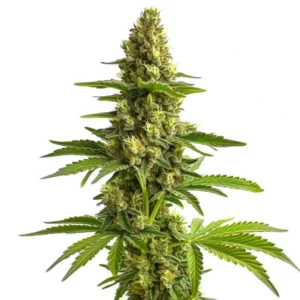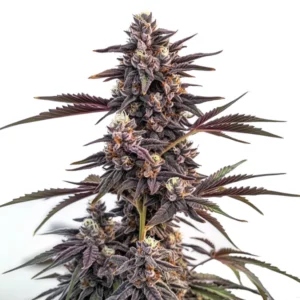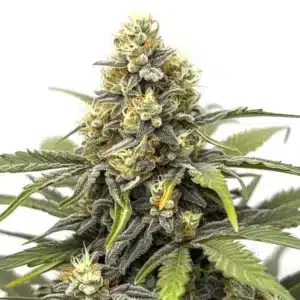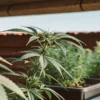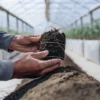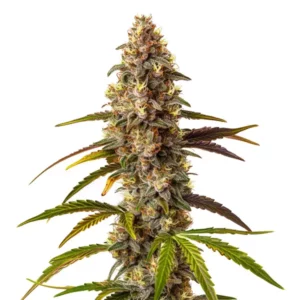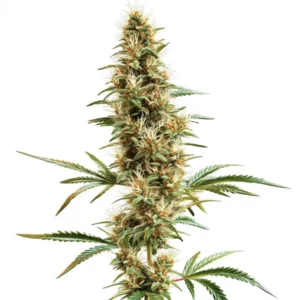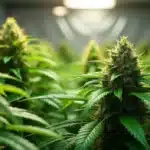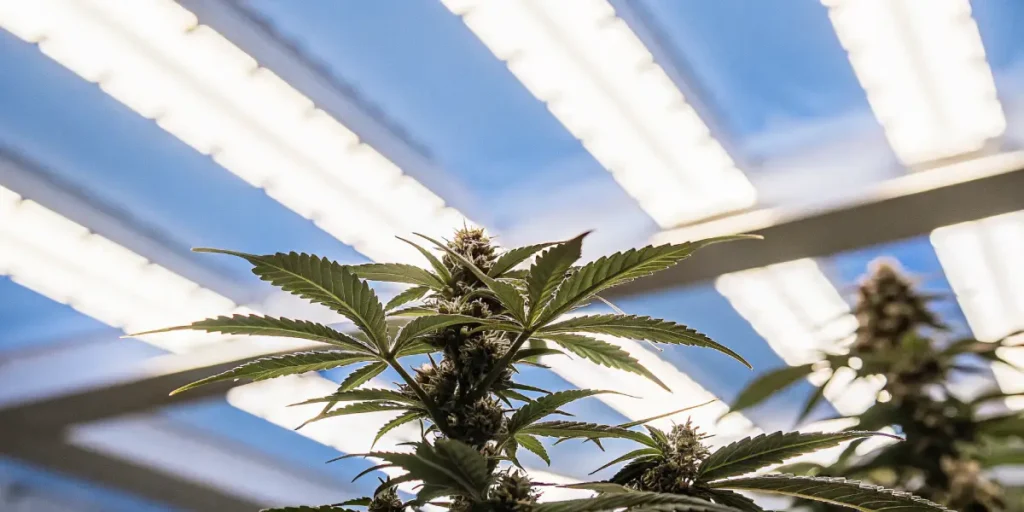
Using Light Quality to Control Cannabis Morphology
Have you ever noticed how plants lean toward the light? This is a simple demonstration of photomorphogenesis in cannabis cultivation. It’s all about how plants, including cannabis, use light to grow and shape themselves. By using light quality to control cannabis morphology, growers can create ideal environments for different growth stages.
Light quality refers to the different wavelengths in light, affecting how cannabis plants grow. By optimizing cannabis growth with light spectrum, you can influence the plant’s height, leaf size, and even the density of buds. This is crucial whether you’re a beginner or a seasoned grower.
Recommended Strains
GG4
|
|
THC | 27% (High) |
|
|
Type | Feminized |
|
|
Yield | High |
|
|
Phenotype | 40% Indica / 60% Sativa |
Bruce Banner #3
|
|
THC | 20% - 29% (High) |
|
|
Type | Feminized |
|
|
Yield | Medium |
|
|
Phenotype | 50% Indica / 50% Sativa |
For instance, if you’re growing Blue Dream seeds from Blimburn Seeds, you might want to modify the light spectrum to encourage bushier growth. This approach not only maximizes yield but also improves the overall quality of your plants.
Impact of Light Quality on Cannabis Plant Structure
Light quality impacts cannabis plant structure significantly. Different light spectrums can trigger various growth responses. For example, blue light tends to promote compact growth with shorter internodal spacing, which means less space between leaves. This is useful for indoor growers who have limited vertical space.
Red light, on the other hand, encourages stretching and vertical growth. If you’re working with a strain like GG4 from Blimburn Seeds, using a red-heavy spectrum can help your plants reach their full height potential. Manipulating cannabis morphology with lighting is a strategic way to control the final shape and size of your plants.
Additionally, the impact of light quality on cannabis plant structure extends to the thickness of stems and development of leaves. By carefully adjusting the spectrum, growers can influence how nutrients are distributed within the plant, leading to a more robust structure that can support heavier yields. This is particularly advantageous when conditions demand sturdy plants that can withstand weighty buds.
Another consideration is the function of supplemental wavelengths such as far-red, which can complement red and blue spectrums to enhance plant growth. Far-red light has been shown to affect flowering time and bud development, making it a valuable tool in the arsenal of spectrum-specific lighting for cannabis morphology control. By tweaking these elements, cultivators can achieve a balance that maximizes both plant health and output.
Optimizing Cannabis Growth with Light Spectrum
Optimizing cannabis growth with light spectrum involves choosing the right balance of blue, red, and other wavelengths. During the vegetative stage, a light spectrum rich in blue light can help create strong, bushy plants. This is particularly beneficial when cultivating strains such as Bruce Banner 3 from Blimburn Seeds, known for their robust growth.
As the plant transitions to the flowering stage, incorporating more red light can enhance bud development. This change in light quality helps the plant focus its energy on producing dense, resin-rich buds. Spectrum-specific lighting for cannabis morphology control is an effective method to boost the overall productivity of your crop.
Leveraging the full spectrum of light allows growers to manipulate the plant’s physiological processes, ensuring that each strain develops to its full potential. By knowing the nuances of photomorphogenesis in cannabis cultivation, growers can strategically plan the lighting phases to align with the plant’s natural growth cycles. This synergy between plant biology and technology is key to achieving optimal results.
Moreover, the adaptability of LED lighting technology enables real-time adjustments to the light spectrum based on the plant’s immediate needs. This flexibility is crucial for addressing environmental changes or unexpected growth patterns, offering growers the ability to respond dynamically to the plant’s development. Thus, using light quality to control cannabis morphology becomes an ongoing, interactive process.
Promos & Deals
Manipulating Cannabis Morphology with Lighting
Manipulating cannabis morphology with lighting is not just about choosing the right spectrum. It’s also about timing. During different growth phases, plants require varied light intensities and durations. Knowing when to switch from a blue-dominant to a red-dominant spectrum can make a big difference.
For example, autoflowering strains, which have a predetermined lifecycle, can benefit from consistent light schedules with gradual spectrum shifts. This ensures that plants like those from Blimburn Seeds thrive from seedling to harvest.
Another aspect of manipulating cannabis morphology with lighting is the integration of light intensity management. By adjusting the intensity, growers can influence photosynthesis rates and, consequently, plant growth and yield. Higher intensity during the vegetative stage can spur rapid growth, while moderate levels during flowering focus energy on bud production.
Moreover, strategic manipulation of light cycles, such as extending daylight hours during the vegetative phase, can enhance growth rates and biomass accumulation. This technique, paired with spectrum-specific adjustments, allows for precision cultivation that aligns with the desired plant morphology and yield outcomes. Such practices underscore the importance of using light quality to control cannabis morphology effectively.
Practical Approaches to Light Management
When managing light for cannabis, consider using a combination of LED lights and natural sunlight. This hybrid approach can provide a broad spectrum of light, enhancing photomorphogenesis in cannabis cultivation. It’s a practical way to achieve a well-rounded light environment.
Installing reflective surfaces around your grow area can increase light exposure. Reflective materials help distribute light evenly, preventing shadows and promoting uniform growth. This technique is especially beneficial for indoor growers using spectrum-specific lighting for cannabis morphology control.
Another practical approach to light management is the use of programmable timers. These devices allow growers to automate light cycles, ensuring consistent light exposure without manual intervention. This automation is particularly useful for maintaining strict schedules that align with the plant’s natural growth patterns.
Additionally, employing light diffusers can mitigate the risk of light burn by softening the intensity at which light strikes the plant’s surface. This is crucial for delicate strains that may be sensitive to high light levels. By refining these practical techniques, growers can optimize the impact of light quality on cannabis plant structure, leading to healthier and more productive crops.
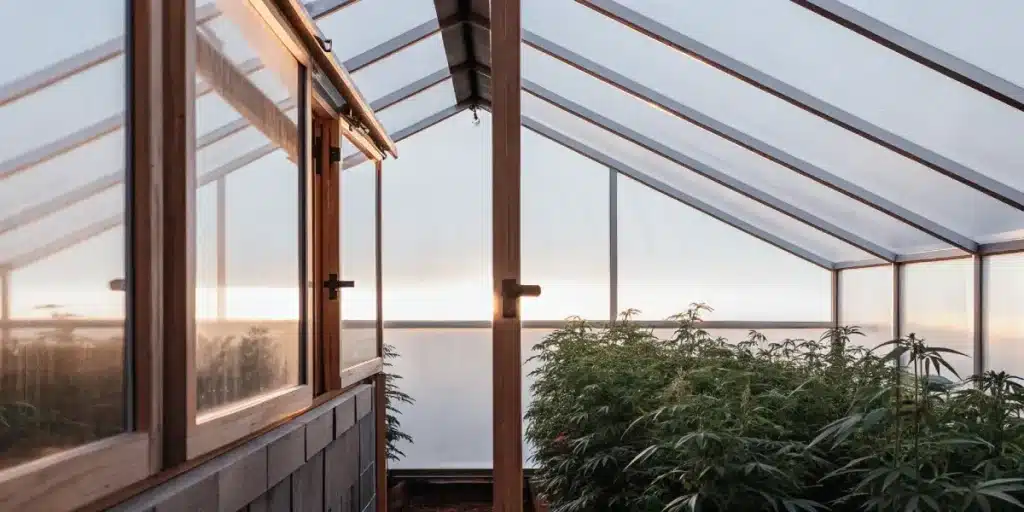
Choosing the Right Equipment for Spectrum-Specific Lighting
Choosing the right equipment is crucial for controlling cannabis morphology with light. LED grow lights are popular due to their energy efficiency and adjustable spectrums. They allow growers to tailor the light environment to match each growth stage.
Invest in lights that offer full-spectrum capabilities. These lights can mimic natural sunlight, providing a balanced mix of blue, red, and far-red light. This versatility is essential for optimizing cannabis growth with light spectrum.
When selecting equipment, consider the balance between upfront cost and long-term benefits. While higher-end LED systems might require a larger initial investment, their energy efficiency and longevity can offer substantial savings over time. This consideration is important for both hobbyists and commercial growers looking to maximize their return on investment.
Furthermore, the inclusion of smart technology in modern lighting systems allows for remote monitoring and adjustments via mobile apps. This feature empowers growers to manage their lighting setups proactively, even when they are away from the grow space. Such advancements in technology highlight the evolving nature of using light quality to control cannabis morphology with precision and convenience.
Setting Up Your Grow Space
Setting up a grow space with optimal lighting involves more than hanging a few grow lights. Consider the spacing and height of your lights. Proper placement ensures that light reaches all parts of the plant, promoting even growth.
Ensure your grow space has adequate ventilation. Good airflow helps regulate temperature and humidity, which are influenced by light intensity. This is important for maintaining a healthy environment for strains like those from Blimburn Seeds.
It’s also crucial to consider the scalability of your grow space setup. Modular lighting systems can be expanded or reduced depending on the growth stage and plant count, offering flexibility to adapt to changing cultivation needs. This scalability is particularly advantageous for growers planning to adjust their operations over time.
Additionally, implementing environmental sensors within the grow space can provide real-time data on temperature, humidity, and light levels. This information is valuable for fine-tuning the growing conditions and ensuring that the impact of light quality on cannabis plant structure is consistently optimized. By integrating these elements, growers can create a controlled environment that supports robust and healthy plant development.
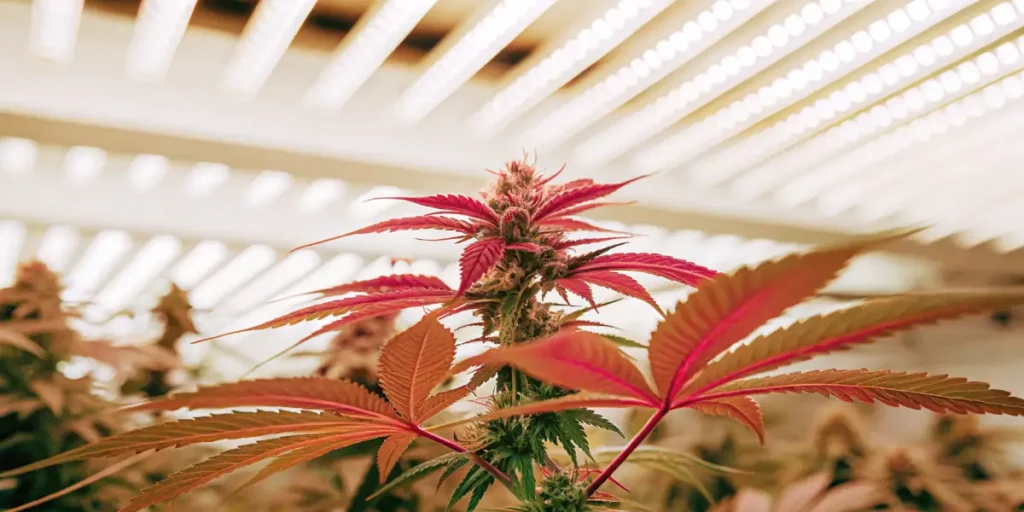
FAQs
How does light quality affect cannabis morphology?
Light quality has a profound impact on cannabis morphology. Different wavelengths in the light spectrum influence how a cannabis plant grows and develops. For instance, blue light promotes bushy, compact growth, which is ideal for maximizing space in indoor grow environments. On the other hand, red light encourages plants to stretch upwards, which can be beneficial for certain strains.
By adjusting the light spectrum, growers can manipulate the plant’s structure to suit their growing conditions. This allows for tailored growth strategies that can improve yield and flower quality. The ability to control these growth factors is crucial for both novice and experienced growers.
Knowing the impact of light quality on cannabis plant structure also involves recognizing how different spectrums affect photosynthetic efficiency. Blue light is known to enhance chlorophyll production, leading to more efficient energy capture and utilization, while red light facilitates flowering processes. These nuances are vital for creating a conducive environment for plant growth.
Moreover, the interplay between light quality and other environmental factors, such as nutrient availability and CO2 levels, can further influence plant morphology. By integrating these elements into a comprehensive cultivation strategy, growers can harness the full potential of photomorphogenesis in cannabis cultivation to achieve superior results.
What are the benefits of using LED lights for cannabis growth?
LED lights offer several advantages for cannabis growth. They are energy-efficient, providing significant savings on electricity costs over time. LEDs have adjustable spectrums, allowing growers to fine-tune the light quality to match different growth stages. This capability is essential for using light quality to control cannabis morphology effectively.
Besides, LEDs generate less heat compared to traditional grow lights, reducing the risk of heat stress on plants. This makes them ideal for indoor growing environments where temperature control is crucial. The longevity of LED lights also means less frequent replacements, contributing to lower long-term costs.
Another benefit of LED lighting is its role in reducing the environmental impact of cannabis cultivation. With lower energy consumption and heat output, LEDs contribute to a more sustainable growing practice, aligning with broader ecological goals. This is increasingly important as the industry moves towards more eco-friendly cultivation methods.
LED technology also allows for targeted spectrum delivery, meaning specific wavelengths can be emphasized or minimized based on the plant’s needs. This precision ensures that the impact of light quality on cannabis plant structure is maximized, leading to healthier plants and more potent yields. As the technology evolves, growers can expect even more sophisticated options to emerge.
Can natural sunlight be integrated with artificial lighting?
Yes, integrating natural sunlight with artificial lighting is a great way to provide a full spectrum of light for cannabis plants. This approach can enhance photomorphogenesis in cannabis cultivation by combining the benefits of both light sources. Natural sunlight offers a broad spectrum that is difficult to replicate artificially, while artificial lights can fill in gaps and extend daylight hours.
For growers with access to natural light, using it in conjunction with LED lights can optimize growth conditions. This hybrid lighting method ensures that plants receive the full range of light wavelengths necessary for healthy development, leading to increased yields and better quality cannabis.
Moreover, the integration of natural and artificial light can help stabilize environmental conditions within the grow space. By utilizing available sunlight, growers can reduce reliance on artificial sources, lowering energy costs while still maintaining optimal light quality for cannabis morphology control.
When strategically managed, this combination can also mitigate the effects of seasonal light variations, allowing for year-round cultivation. By harnessing the strengths of both natural and artificial lighting, growers can create an adaptable and efficient cultivation system that supports robust plant growth and development.
How can growers adjust lighting during different growth stages?
Adjusting lighting during different growth stages is key to manipulating cannabis morphology with lighting. During the vegetative stage, a higher proportion of blue light encourages bushy growth and strong stems. As the plant transitions to the flowering stage, increasing red light can stimulate bud production and enhance flower density.
Growers can achieve these adjustments by using LED lights with customizable spectrums. This flexibility allows for precise control over the plant’s light environment, ensuring optimal conditions throughout its lifecycle. Regular monitoring and adjustments help maximize growth and yield potential.
Besides to spectrum adjustments, varying light cycles—such as altering the duration of light exposure—can influence the plant’s growth patterns and flowering times. By tailoring light schedules to the specific requirements of each growth stage, cultivators can ensure that their plants receive the ideal conditions for each phase of development.
Furthermore, incorporating supplemental lighting during critical periods can provide an extra boost to plant growth and health. This strategy is particularly useful in regions with limited natural light, allowing growers to maintain consistent conditions for optimizing cannabis growth with light spectrum, regardless of external factors.
Why is reflective material important in a grow space?
Reflective material is important in a grow space because it maximizes light efficiency. By bouncing light back onto the plants, reflective surfaces ensure that every part of the plant receives adequate light exposure. This reduces shadows and promotes uniform growth, which is essential for healthy development.
Using reflective materials can also lead to energy savings. More light reaching the plants means less reliance on additional light sources, lowering electricity costs. For indoor growers, incorporating reflective surfaces into their setup is a practical step towards optimizing cannabis growth with light spectrum.
Reflective materials, such as mylar or white paint, can significantly enhance the effectiveness of your lighting setup by minimizing light loss and improving coverage. This is particularly beneficial in small grow spaces where maximizing available light is crucial for achieving optimal growth.
Incorporating reflective surfaces also contributes to a more consistent light distribution, which can prevent uneven growth and help maintain uniform plant morphology. By ensuring that all parts of the plant receive equal light exposure, growers can achieve higher quality yields and healthier plants overall.



